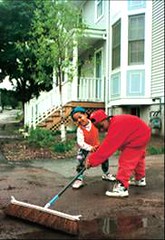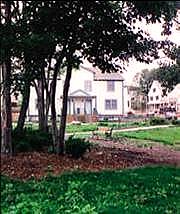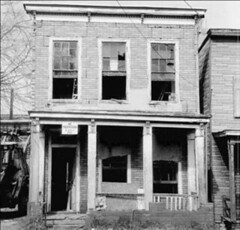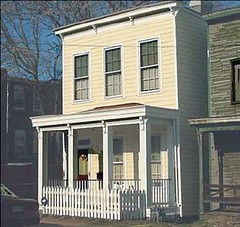Smart means inclusive

Posted January 22, 2008 at 11:20PM
 Because of various remembrances of Dr. King on Monday, I reminded myself that no one has been hurt by sprawl more than low-income, inner-city, frequently minority populations. When jobs and investment have fled to new pastures (literally), their neighborhoods have been left behind. The long-term effect of the transfer of economic activity and affluence to increasingly distant suburban locations has been a diminishing tax base and a sustained cycle of decline in many older communities.
Because of various remembrances of Dr. King on Monday, I reminded myself that no one has been hurt by sprawl more than low-income, inner-city, frequently minority populations. When jobs and investment have fled to new pastures (literally), their neighborhoods have been left behind. The long-term effect of the transfer of economic activity and affluence to increasingly distant suburban locations has been a diminishing tax base and a sustained cycle of decline in many older communities.
One of the pillars of smart growth is reinvestment in our older communities, and we are seeing the fruits of success in many places, including DC’s Penn Quarter, the subject of my last post. But this, too, must be done with care, since gentrification can displace and disrupt older communities. We must invest in ways that strengthen rather than harm current residents of reinvestment areas, and involve existing residents in planning efforts.
And today I salute a couple of my favorite examples:
 First, the Dudley Street neighborhood in Boston is one of the best studies in grassroots planning and neighborhood transformation you can find anywhere. By the 1980s, Dudley Street had become the poorest neighborhood in Massachusetts, with a third of its land vacant and half its housing stock either burned down or destroyed. It had become a dumping ground for abandoned vehicles and illegal trash transfer operations, a poster child for everything that can go wrong in the inner city.
First, the Dudley Street neighborhood in Boston is one of the best studies in grassroots planning and neighborhood transformation you can find anywhere. By the 1980s, Dudley Street had become the poorest neighborhood in Massachusetts, with a third of its land vacant and half its housing stock either burned down or destroyed. It had become a dumping ground for abandoned vehicles and illegal trash transfer operations, a poster child for everything that can go wrong in the inner city.
Yet, the community remained rich in caring residents. In response to rumors of a development plan that might be imposed from outside, the neighbors organized themselves, started holding informal meetings and, to make a long story manageably short, formed their own initiative and corporation with the goal of creating a home-grown urban village to their own vision. They raised money for the effort from the Riley and Ford Foundations, and over 200 neighbors participated in the process.
 Key to their success was obtaining recognition as an urban redevelopment organization under Massachusetts state law, with the right of eminent domain. This enabled the Dudley Neighbors to reclaim abandoned land and place it in a neighborhood land trust for conversion to affordable housing and parks. Today, Dudley Street has been cleaned up; hundreds of units of affordable housing have been built; the neighborhood’s transit station has reopened; and there is a new community center, high school and weekly farmer’s market. What was once a symbol of despair is now a model of hope and aspiration.
Key to their success was obtaining recognition as an urban redevelopment organization under Massachusetts state law, with the right of eminent domain. This enabled the Dudley Neighbors to reclaim abandoned land and place it in a neighborhood land trust for conversion to affordable housing and parks. Today, Dudley Street has been cleaned up; hundreds of units of affordable housing have been built; the neighborhood’s transit station has reopened; and there is a new community center, high school and weekly farmer’s market. What was once a symbol of despair is now a model of hope and aspiration.
(NRDC does not support the use of eminent domain, which is subect to abuse, in all cases. In this case it was used carefully and properly for the public good.)
On a broader scale, the National Vacant Properties Campaign was formed several years ago to help other cities and neighborhoods do what Dudley Street did. In particular, “the campaign provides innovative strategies and tools to transform abandoned houses, boarded factories, vandalized stores, and vacant lots into safe, inviting places for people to work, live, and play.” It is a project of Smart Growth America, the Local Initiatives Support Corporation, and the Metropolitan Institute at Virginia Tech.
The nationwide scope of the challenge is difficult to measure. But, according to the Brookings Institution, vacant and abandoned properties occupy about 15 percent of the area of the typical large city, more than 12,000 acres on average. This is potentially productive land already connected to urban infrastructure. For metropolitan areas looking to accommodate growth without consuming the surrounding countryside, these properties amount to a large reservoir of land for well-planned, inclusive development.


The Vacant Properties Campaign, which stresses working with current neighborhood residents, has built an internet portal for policies, best practices, research, and news. The site compiles the most relevant information for anyone interested in issues related to vacant properties, how communities throughout the country are addressing them, and how to reach the experts. The site’s campaign reports and presentations section is particularly rich in materials on the subject. The campaign is also doing model work to provide particular assistance to community organizations in seven cities: Baltimore, Bridgeport, Buffalo, Indianapolis, Richmond, Spartanburg, and Tucson.
To succeed, smart growth must provide something for everyone. That’s what these two initiatives are doing, and I like to think Dr. King would be pleased.